Stardew Valley Foraging
Foraging, Chopping Wood, and Collecting
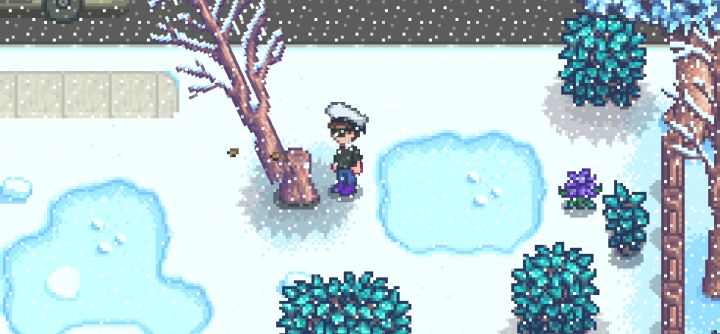 Chopping trees outside of the farm is not a bad idea. You'll find foraged items along the way and the trees will respawn.
Chopping trees outside of the farm is not a bad idea. You'll find foraged items along the way and the trees will respawn.
Foraging is the act of chopping wood and collecting wild fruits and vegetables. Stardew Valley's Foraging Skill unlocks some useful crafting recipes, all the while making your use of the axe for woodcutting more efficient. Here's a guide to how foraging works, when you'll gain skill experience, and what some of the unlocked crafting items will do for your character.
Foraging Skill XP - How to Level
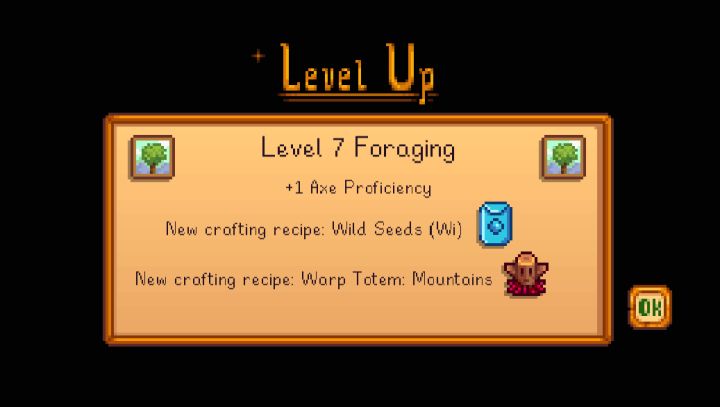 Each level of foraging increases axe proficiency while also unlocking crafting recipes for your character.
Each level of foraging increases axe proficiency while also unlocking crafting recipes for your character.
This skill levels slowly, and is likely the one you'll cap last unless you focus on it. Foraging Skill experience is gained at a flat rate every time you fell a fully-grown tree or chop a stump or log that provides hardwood. You also gain foraging skill levels by picking wild fruits and vegetables from around the game world. When you grow wild seeds, that counts as foraging XP but isn't as much experience as you'd get when collecting those items in the wild. This is because it's not too hard to make dozens of foraged plants on your farm in any given season.
There are a few big things to note that will speed up your leveling process with Foraging. First, you can plant rows of trees and chop them down with a more advanced axe. The axe, when upgraded, can bring trees down with fewer and fewer hits the better its quality.
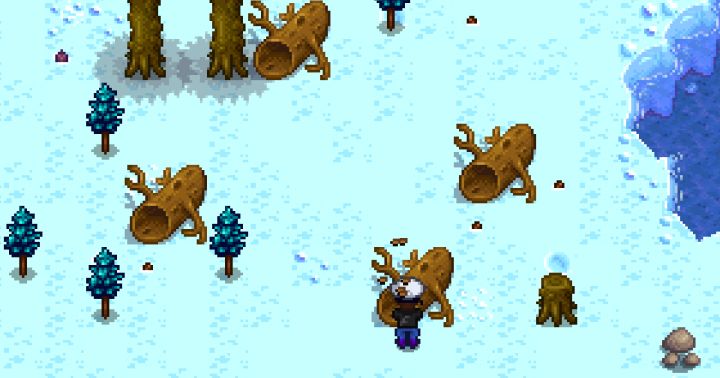 Stumps that drop hardwood are likely to give foraging experience, though it's hard to confirm.
Stumps that drop hardwood are likely to give foraging experience, though it's hard to confirm.
Secondly, clearing areas outside of your farm - in particular the woods to the south - will give more room for wild plants to appear. The more empty space, the better they will spawn. Finally, using the Seed Maker will let you plant foraging crops on your farm. You get less than half the XP, but it's easy to make dozens of seeds for each season if you find the key items to put into the seed maker. The first two methods are probably the fastest ways to level foraging.
It would appear from my testing that you do not gain any experience from digging things up with the hoe or else the XP amounts are too small to notice even on a level 0 foraging character.
Axe Proficiency
At the start of the game, chopping down a tree is the most strenuous activity in the game. Thankfully, with each level of Foraging, your character's axe proficiency increases. This reduces the energy used for a chop but does not reduces the amount of chops needed. Going to the Blacksmith and having him upgrade your axe will make your woodcutting ability even better by reducing the needed swings.
Foraging Skill Crafting Unlocks
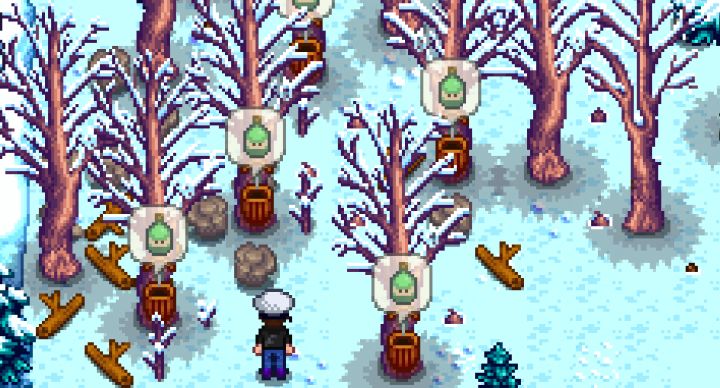 Tappers let you collect sap from trees, which are useful crafting materials and cooking ingredients.
Tappers let you collect sap from trees, which are useful crafting materials and cooking ingredients.
- Level 1 - Wild Seeds (Spring) crafting ability, Field Snack recipe (restores energy and a little health)
- Level 2 - Survival Burger recipe (temporarily raises foraging level, making woodcutting consume less energy)
- Level 3 - Tapper (build and attach to get maple syrup, oak resin and pine tar about once a week from trees)
- Level 4 - Charcoal Kiln (build to turn wood into coal), Wild Seeds (summer) crafting ability.
- Level 5 - Choose between Forester and Gatherer Professions.
- Level 6 - Lightning Rod (turns summer lightning strikes into batteries), Wild Seeds (Fall) crafting recipe, Warp Totem (Warp to Beach)
- Level 7 - Wild Seeds (Winter) crafting recipe, Warp Totem (Warp to Mountains)
- Level 8 - Warp Totem (Warp to Farm)
- Level 9 - Rain Totem (Makes it more likely to rain the next day)
- Level 10 - If you chose Forester at level 5, choose between Lumberjack (more hardwood) and Tapper (Syrup worth 25% more). If you chose Gatherer, choose between Botanist (Foraged are always gold quality) and Tracker (foraged items easier to track)
Warp totems are one-time use items that you can use when you have an excess of supplies. The cooking recipes you unlock requires you to have Robin build on to the house, as you do not have a kitchen at the start of the game. Placing fruits and veggies along with some foraged items in the refrigerator is a good idea, as it draws off that inventory in order to show what foods you are able to cook. Food is primarily useful for going into the mines.
Foraging Locations
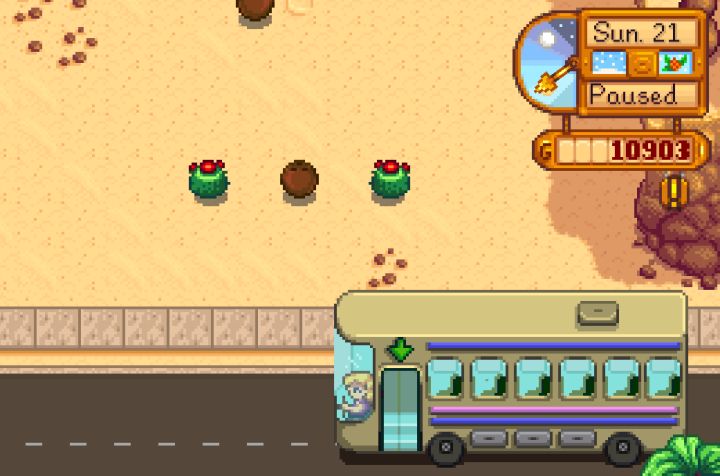 The cactus and coconuts at the desert (which you can reach when the bus is repaired) are examples of plants that give you foraging skill xp.
The cactus and coconuts at the desert (which you can reach when the bus is repaired) are examples of plants that give you foraging skill xp.
Foraging items are spawned daily, but not reliably. You should hit up the areas you've noticed foraging items every other day. Each week there is a surge of extra items (7th, 14th, 21st, 28th) and those are good days to go clear the areas to make more room for foraged items to spawn. By far the best foraging location is the woods south of your farm. Additionally, items will spawn in town, on the beach, and up in the mountains. Nearly everywhere but not on your farm! Collecting these is not only one way to get foraging xp, but also provides food, income, and occasionally lets you finish off one of several foraging-related bundles at the Community Center.
Woodcutting
You can replant trees once you reach level 1 Foraging and they begin dropping seeds. This can let you use tappers to farm many of the syrups and resins from trees. Additionally, you can set them up in rows and mow them down with a good axe to get plenty of Foraging XP and wood for your crafting projects. It is worth noting that trees outside of your farm will respawn, though you can not cut every tree type (some are decorative). This mainly applies to the woods and areas away from the town. See my guide to trees, how to tell them apart and how to plant them for more information.
